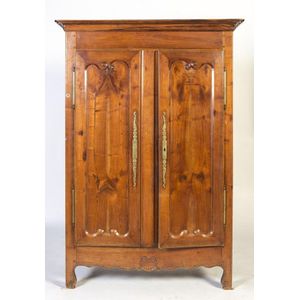French Walnut and Oak Cupboard, Dated 1817
You must be a subscriber, and be logged in to view price and dealer details.
Subscribe Now to view actual auction price for this item
When you subscribe, you have the option of setting the currency in which to display prices to $Au, $US, $NZ or Stg.
- Oak - Native to Europe and England, oak has been used for joinery, furniture and building since the beginning of the medieval civilisation. It is a pale yellow in colour when freshly cut and darkens with age to a mid brown colour.
Oak as a furniture timber was superceded by walnut in the 17th century, and in the 18th century by mahogany,
Semi-fossilised bog oak is black in colour, and is found in peat bogs where the trees have fallen and been preserved from decay by the bog. It is used for jewellery and small carved trinkets.
Pollard oak is taken from an oak that has been regularly pollarded, that is the upper branches have been removed at the top of the trunk, result that new branches would appear, and over time the top would become ball-like. . When harvested and sawn, the timber displays a continuous surface of knotty circles. The timber was scarce and expensive and was used in more expensive pieces of furniture in the Regency and Victorian periods. - Escutcheons - An escutcheon is a plate, made of brass, wood, ivory or ebony, which fits into or over the h keyhole, to protect the edge of the timber keyhole from damage by continual insertions of the key. As a general rule you would expect these escutcheons to be sympathetic in design to the handles of the piece. From the early 19th century escutcheons were sometimes made from ivory, ebony, bone or contrasting wood, often cut in a diamond or shield shape and inlaid into the front. Ivory, in particular, will tend to discolour with age, and certainly should not show up as brilliantly white.
This item has been included into following indexes:
Visually similar items

A French provincial Cherrywood armoire with later cornice, 18th /19th century, 204 cm high, 142 cm wide, 68 cm deep

A French fruit wood armoire of large proportion, 19th century, 225 cm high, 130 cm wide, 50 cm deep

A French oak double door armoire, the doors, pediment, apron and cornice carved with various ornate floral and geometric designs in high relief, the doors with ornate brass escutcheons and elongated hinges opening to reveal fitted shelves and drawers. A dr

A 17th century French provincial armoire, with a moulded cornice above a double panelled door, with pinned panel sides on block feet. 185 cm high, 90 cm wide, 61 cm deep
